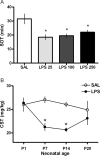Postnatal inflammation increases seizure susceptibility in adult rats
- PMID: 18596165
- PMCID: PMC3547980
- DOI: 10.1523/JNEUROSCI.1901-08.2008
Postnatal inflammation increases seizure susceptibility in adult rats
Abstract
There are critical postnatal periods during which even subtle interventions can have long-lasting effects on adult physiology. We asked whether an immune challenge during early postnatal development can alter neuronal excitability and seizure susceptibility in adults. Postnatal day 14 (P14) male Sprague Dawley rats were injected with the bacterial endotoxin lipopolysaccharide (LPS), and control animals received sterile saline. Three weeks later, extracellular recordings from hippocampal slices revealed enhanced field EPSP slopes after Schaffer collateral stimulation and increased epileptiform burst-firing activity in CA1 after 4-aminopyridine application. Six to 8 weeks after postnatal LPS injection, seizure susceptibility was assessed in response to lithium-pilocarpine, kainic acid, and pentylenetetrazol. Rats treated with LPS showed significantly greater adult seizure susceptibility to all convulsants, as well as increased cytokine release and enhanced neuronal degeneration within the hippocampus after limbic seizures. These persistent increases in seizure susceptibility occurred only when LPS was given during a critical postnatal period (P7 and P14) and not before (P1) or after (P20). This early effect of LPS on adult seizures was blocked by concurrent intracerebroventricular administration of a tumor necrosis factor alpha (TNFalpha) antibody and mimicked by intracerebroventricular injection of rat recombinant TNFalpha. Postnatal LPS injection did not result in permanent changes in microglial (Iba1) activity or hippocampal cytokine [IL-1beta (interleukin-1beta) and TNFalpha] levels, but caused a slight increase in astrocyte (GFAP) numbers. These novel results indicate that a single LPS injection during a critical postnatal period causes a long-lasting increase in seizure susceptibility that is strongly dependent on TNFalpha.
Figures






Similar articles
-
Postnatal systemic inflammation exacerbates impairment of hippocampal synaptic plasticity in an animal seizure model.Neuroimmunomodulation. 2013;20(4):223-32. doi: 10.1159/000348440. Epub 2013 May 30. Neuroimmunomodulation. 2013. PMID: 23736043
-
Glia activation and cytokine increase in rat hippocampus by kainic acid-induced status epilepticus during postnatal development.Neurobiol Dis. 2003 Dec;14(3):494-503. doi: 10.1016/j.nbd.2003.08.001. Neurobiol Dis. 2003. PMID: 14678765
-
Kainic acid-activated microglia mediate increased excitability of rat hippocampal neurons in vitro and in vivo: crucial role of interleukin-1beta.Neuroimmunomodulation. 2010;17(1):31-8. doi: 10.1159/000243083. Epub 2009 Oct 5. Neuroimmunomodulation. 2010. PMID: 19816055
-
Increased Excitatory Synaptic Transmission Associated with Adult Seizure Vulnerability Induced by Early-Life Inflammation in Mice.J Neurosci. 2021 May 19;41(20):4367-4377. doi: 10.1523/JNEUROSCI.2667-20.2021. Epub 2021 Apr 7. J Neurosci. 2021. PMID: 33827934 Free PMC article.
-
Neuroinflammation as a neurotoxic mechanism in alcoholism: commentary on "Increased MCP-1 and microglia in various regions of human alcoholic brain".Exp Neurol. 2008 Sep;213(1):10-7. doi: 10.1016/j.expneurol.2008.05.016. Epub 2008 Jul 14. Exp Neurol. 2008. PMID: 18625499 Free PMC article. Review. No abstract available.
Cited by
-
Molecular mechanisms of neonatal brain injury.Neurol Res Int. 2012;2012:506320. doi: 10.1155/2012/506320. Epub 2012 Jan 26. Neurol Res Int. 2012. PMID: 22363841 Free PMC article.
-
Exposure to prenatal stress enhances the development of seizures in young rats.Metab Brain Dis. 2012 Sep;27(3):399-404. doi: 10.1007/s11011-012-9300-3. Epub 2012 Apr 17. Metab Brain Dis. 2012. PMID: 22527993
-
Pharmacological Tools to Activate Microglia and their Possible use to Study Neural Network Patho-physiology.Curr Neuropharmacol. 2017;15(4):595-619. doi: 10.2174/1570159X14666160928151546. Curr Neuropharmacol. 2017. PMID: 27697040 Free PMC article. Review.
-
Early-life programming of later-life brain and behavior: a critical role for the immune system.Front Behav Neurosci. 2009 Aug 24;3:14. doi: 10.3389/neuro.08.014.2009. eCollection 2009. Front Behav Neurosci. 2009. PMID: 19738918 Free PMC article.
-
Anti-Epileptic Effect of Crocin on Experimental Temporal Lobe Epilepsy in Mice.Front Pharmacol. 2022 Mar 31;13:757729. doi: 10.3389/fphar.2022.757729. eCollection 2022. Front Pharmacol. 2022. PMID: 35431921 Free PMC article.
References
-
- Agrawal AK, Shapiro BH. Neonatal phenobarbital imprints overexpression of cytochromes P450 with associated increase in tumorigenesis and reduced life span. FASEB J. 2005;19:470–472. - PubMed
-
- Allan SM, Rothwell NJ. Cytokines and acute neurodegeneration. Nat Rev Neurosci. 2001;2:734–744. - PubMed
-
- Allan SM, Tyrrell PJ, Rothwell NJ. Interleukin-1 and neuronal injury. Nat Rev Immunol. 2005;5:629–640. - PubMed
-
- Annegers JF, Hauser WA, Beghi E, Nicolosi A, Kurland LT. The risk of unprovoked seizures after encephalitis and meningitis. Neurology. 1988;38:1407–1410. - PubMed
Publication types
MeSH terms
Substances
Grants and funding
LinkOut - more resources
Full Text Sources
Other Literature Sources
Medical
Research Materials
Miscellaneous
